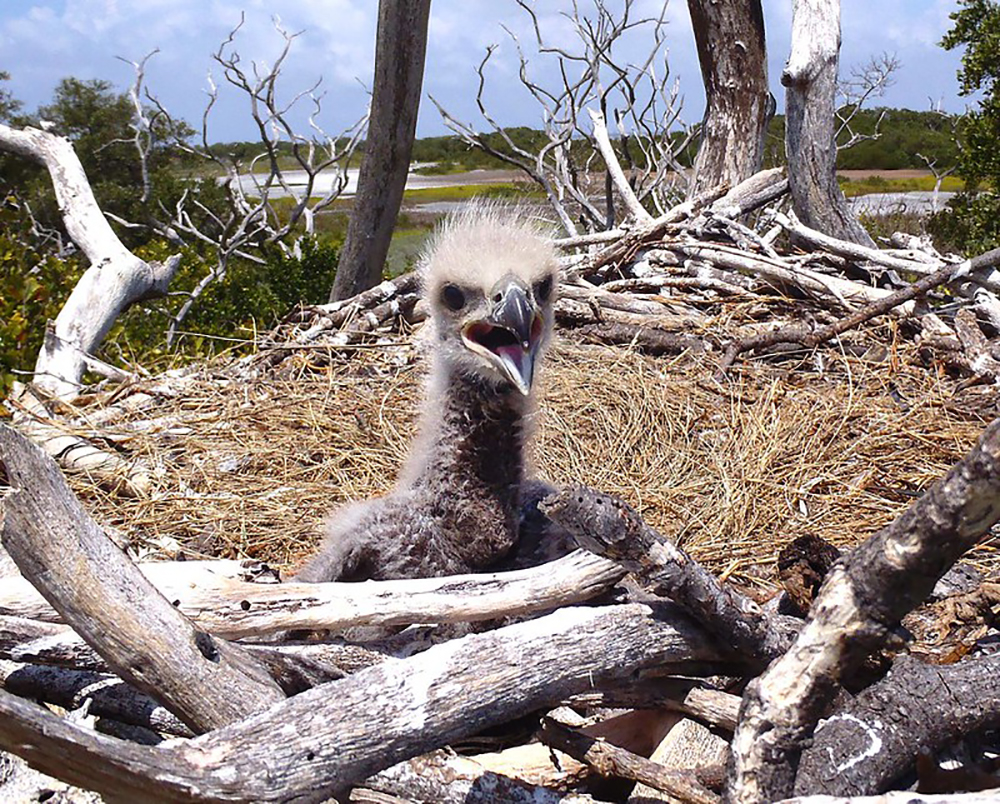
By Laura Kiesel
I rushed to the cemetery when I heard the news, hoping it had been a false rumor. When I arrived, I aimed my camera up at the large nest that took up more than half the tree top and zoomed in. It was completely empty.
The bald eagle I had watched grow from a fuzzy helpless chick to a strong and agile juvenile was gone. Soon after MassWildlife confirmed the rumor: the eaglet died after consuming a class of rat poisons known as second generation anticoagulant rodenticides known as SGARs.
SGARs had been banned by the US Environmental Protection Agency (EPA) for over-the-counter sales because tens of thousands of young children ended up in the emergency room yearly from accidental ingestion, which the manufacturers found an acceptable risk.
After years of court battles, SGAR manufacturers came to a compromise with the EPA. SGARs would be removed from shelves of retail stores, but they could still be used in so-called “tamper-resistant” bait stations that licensed pest control operators could install for customers around their residences or businesses.
There are four kinds of SGARs: brodifacoum, bromadiolone, difethialone, and difenacoum. They all work the same way—by stopping blood from clotting. However, this deadly effect is not limited to only the animal that eats the poison.
Here’s the typical scenario: a mouse or rat eats the poison, but it doesn’t die right away. It may feed repeatedly from the bait, to the point where the poison is accumulated in very high amounts in its system. Over the course of several days, that rodent becomes very weak. It will stagger like it’s drunk or drugged. Rodents in this state make easy prey, especially for young wildlife just learning to hunt on their own.
That is what happened to the recently fledged eaglet in Arlington; it had been eating poisoned rats that were easy catches. This was the second bald eagle in the Boston metro area to die in only a matter of a few months from secondary SGARs poisoning. The other one had died in Waltham, a cousin of this eagle. In 2018, another bald eagle on Cape Cod was found ill from SGARs poisoning and had to be euthanized.
Only a few decades earlier, bald eagles did not exist in Massachusetts. Like in most other parts of the United States, their populations had been nearly wiped out from the pesticide DDT.
DDT was eventually banned and careful planning to reintroduce eagles has led to the restoration of their species in the state and much of the country. Now some 80 pairs of bald eagles nest in the Bay State. But it seems like we are wasting those efforts by not learning from our history. We are repeating our mistakes, replacing one toxin with another.
A recent study found that 100% of the red-tailed hawks tested at Tufts Wildlife Clinic Massachusetts were positive for SGARs exposure, while 86% of birds of prey in the state tested positive for SGARs in a prior study. The sad irony too is SGARs may actually be making rat populations grow.
Rats are prolific breeders. A single pair can give birth to thousands of young in a single year, with climate change lengthening their reproductive cycles. So by the time one generation of rats succumbs to the poison, the next has already been born. Plainly put: rats can outbreed most poisons. Some studies suggest with subsequent generations, rats can even learn to avoid poisons.
Meanwhile, many rat predators do not have high birth rates, and their populations cannot withstand the hit of poisonings. Bald eagles, and most birds of prey, only give birth to one to four offspring a year. If they succumb to poison, the likelihood of their populations rebounding is much lower than for rodents.
We’re essentially drawing rodents to us with bait that then kills off their natural predators. And by doing that, we’re working against ourselves: one study revealed that raptors are 50% more effective at controlling rodents than anti-coagulant poisons.
What Can Be Done
On the state level, there is a bill that is seeking to address this issue, H.3991 “An Act Relative to Pesticides.” Introduced by Representative James Hawkins (D-Attleboro) in collaboration with environmental and animal welfare groups like MassAudubon and MSPCA, the bill seeks to reduce use of SGARs by promoting integrated pest management (IPM) and modernizing pesticide use tracking. In particular, this legislation would require exterminators to disclose the risks of SGARs to non-target species to consumers and require signed records confirming that disclosure. It would also emphasize non-poisonous alternatives.
Currently, H.3991 is expected to have its hearing sometime in the next several months at the Joint Committee on Environment, Natural Resources and Agriculture. As such, it’s critical that H.3991 get as much bicameral support as possible. You can check to see if your State Senator or House Rep has signed on as a co-sponsor at MAlegislature.gov/Bills/192/HD4206.html. If they are not signed up as a co-sponsor, write them as a constituent and ask them to do this, and ask your other Massachusetts friends and family to do the same with their senators and representatives.
On the local level, municipalities like Belmont may want to consider warrant articles that ban the use of SGARs on town-owned and managed lands as well as warrant articles that formally implement an IPM plan that focuses on better trash management and alternatives to poisons.
For instance, the city of Somerville piloted the use of a nonlethal rat contraception bait called ContraPest at a few locations with high rodent activity. Those areas subsequently experienced a 57% and 67% reduction in rat sightings. Somerville also issued rat-resistant trash toters to every resident of the city and installed a number of rat-resistant Big Belly trash cans in public areas with a lot of foot traffic. As of 2018, Somerville had experienced a 36% decrease in rat sightings as a result of these efforts.
Belmont residents can also communicate with businesses using bait that they prefer their dollars go to supporting places that do not rely on rodenticides—especially SGARs—but instead take sustainable and humane approaches that do not harm wildlife or people’s pets.
So next time you see a bait station, please consider the world we’re creating for ourselves and our kids, and if our war with rats is worth decimating all other species that rely on rodents as a critical staple of their diets.
Laura Kiesel is a freelance writer and editor focusing on environmental and health topics. Her articles have been published in The Atlantic, Politico, The Guardian, Salon, Al-Jazeera, the Washington Post, Vice, Vox, Ozy, the New York Daily News, Science and many more.




Sorry, the comment form is closed at this time.